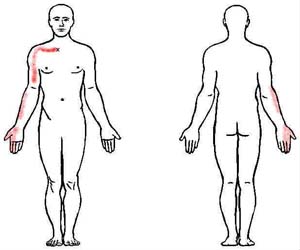
Chiropractor Chandler AZ
Subclavius Trigger Point

The subclavius muscle has its origin in the first rib and cartilage. Its insertion is found in the subclavian groove of clavicle (inferior surface of middle third of clavicle), while it is innervated by the subclavian nerve.
The symptom areas are found in the upper back, shoulder, and the arm. The primary symptomsdevelop in the front of arm causing pain in the front of chest. The secondary symptoms of pain can be found in the dorsal finger, front of shoulder, radial forearm, thumb and radial hand. The diagram below shows the trigger point (x) and the referred pain path in red which affects the front of the chest all the way down the arm to the hand and fingers.
Conservative Treatments
Therapeutic treatments for addressing soft tissue injuries involve massage therapy, manual therapy, trigger point therapy, Graston Technique, or Active Release Technique. These treatments increase blood flow, decrease muscle spasms, enhance flexibility, speed healing, and promote proper tissue repair.
When these treatments are incorporated into a treatment plan patients heal faster and are less likely to have long-term pain or soft tissue fibrosis or scar tissue in the injured muscle. These soft tissue treatments are incorporated with therapeutic exercise and flexibility programs.
Subclavius trigger points are more likely in people with movement and muscular dysfunction in the neck and shoulder. People may originally develop a shoulder sprain or tendinosis through acute trauma or chronic repetitive activities. Patients may also have a subtle case of costochondritis. When the initial injury does not heal, people compensate for their shoulder dysfunction by overwork the trapezius, SCM, scalenes, pectoralis major, pectoralis minor, subclavius, and scapular stabilizer muscles.
Treatment for shoulder injuries often requires a variety of exercises, stretches, conservative treatments, medical treatments, and home therapies. Shoulder injuries can become chronic if the appropriate steps are not taken.
Elbow injuries often occur in people with severe or chronic shoulder injuries. People begin trying to alter their shoulder motions to protect it. Unfortunately these altered body mechanics tend to overwhelm the muscles and tendons around the elbow. People often develop a secondary lateral epicondylitis, tricep tendonitis, medial epicondylitis, pronator teres syndrome.
Treatment for elbow injuries can be extensive if the tendinosis is severe. Mild strains can be treated at home with PRICE, home stretches, and exercises. Don’t wait for damage to both the shoulder and elbow to seek treatment and therapy.
Medical Treatments
NSAIDs are often prescribed for the initial acute injury stages. In severe cases that involve multiple joint regions, muscle relaxers or oral steroids can be given. Trigger point injections, botox, or steroid injections can be treatment options. Pain management is not usually required unless stronger medications or joint injections are required for treatment.
MRI and X-rays will not usually be ordered to evaluate mild to moderate muscle, tendon, and ligament injuries. Severe cases may utilize advanced imaging to rule out bone fractures, edema, nerve entrapments, tendon or muscle ruptures. NCV testing may be utilized in cases that also involve muscle, sensory, or reflex loss.
Cervical spinal disc bulges and herniations onto the spinal cord or nerve root produce different symptoms and location of symptoms. Your chiropractor, physical therapist, occupational therapist, or physician will evaluate your condition and make a proper diagnosis and treatment recommendations. Ask them any questions you might have about your injury.
Conclusion
The upper extremity works as a comprehensive unit performing many of the repetitive tasks at home, work, and recreational sports. Injuries to one area of the musculature often indicate that additional damage has been incurred by other muscles.
Many therapeutic exercises can help restore proper strength and endurance to the elbow flexor muscles. Isometric exercises are often the initial treatment exercises. Followed by single plane rubber band exercises for elbow flexion, extension, pronation, and supination movements. Dynamic exercises involving stability ball push-ups can be performed on the wall or floor. The more unstable of the surface the more effort and stabilization is required of all the upper extremity muscles.
Push-ups on a stability ball enhances neuromuscular learning throughout the neck, scapula, shoulder, upper arm, and lower our muscles. Additional strength exercises can be found on the arm and shoulder strengthening pages.
Our Chandler Chiropractic & Physical Therapy clinic treats patients with a variety of muscle, tendon, joint, and ligament injuries. The clinic provides treatment for runners, tri-athletes, and weekend warriors in addition to common headache, neck, and back patients traditionally seen in Chiropractic, Physical Therapy, Massage Therapy clinics. We work with all ages and abilities of the residents in Phoenix, Tempe, Gilbert, Mesa, and Chandler AZ.